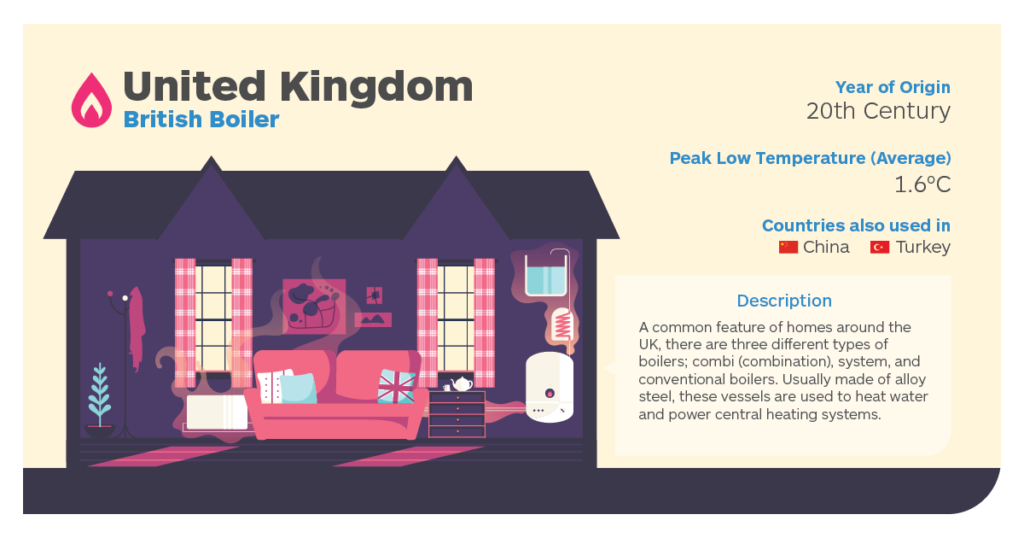Here’s How Other Countries Keep Warm

With winter in full swing, homes around the world will be employing different techniques to fend from the cold. For centuries, cultures have found new-fangled methods of generating and containing heat within their homes. These are often ancient traditions that inform household technology used in the current day.
Leading energy supplier npower have produced an interactive animation that shows how a number of regions heat their homes. From the popular Scandinavian ‘Hygge’ to the Korean ‘Ondol’, the creative design brings to life different interiors from all over the globe.
Scandi Style
One of the biggest phenomenons of the last few years, ‘Hygge’ has been adopted by many beyond Denmark and Norway as a way of life. Translating from Danish as a word meaning ‘to give comfort and joy’, this lifestyle concept has extended into how people design and style their own homes.
The animation shows some of the key features of a ‘Hygge home’
- Keep it Comfy – Pillows and blankets are often used in Hygge interiors to make bold statements to create and keep that warm feeling
- Light up your Living Room – Hygge is about simplicity and a comfortable existence. The natural and raw elements of candles and fireplaces illuminate the home and keep you toasty.
- Stylish Stoves – The AGA cooker is famed for its longevity and heat-storing properties but its rustic Scandinavian design see it effortlessly fit into the ‘Hygge’ way.
Korean Comfort
The Korean ‘Ondol’ heating method is a traditional method that creates underfloor warmth using direct heat from wood smoke. Dating back to 1000 BC, the technique inspires modern systems found in homes in the present day.
- Agungi – The firebox that begins the heating process is often placed outside the home and then navigates heat into the home.
- Butu-Mak – As well as providing heat, above the firebox is a cooking area that was used to provide meals for families.
- Ondol Floor – The smoke circulates underneath the home, heating slabs (goodlejang) and stones (guemdol) that help to retain the warmth.
Russian Rooms
Much like an AGA, the Russian ‘Pechka’ is a large masonry stove that has been used for centuries for both cooking and domestic heating. Some key features include:
- Pechka – The stove is often compiled of brick, stone and clay that absorb heat quickly but cool slowly, often only needing to be lit twice a day to warm the entire home.
- Hearth – The ovens often have two hearths which are used for different types of cooking and smoking. People sometimes sleep close to the hearths in harsh winters.
Big in Japan
The Japanese ‘Kotatsu’ is another multi-purpose method which combines heat and the central point of a living room area where families can sit and eat. Still used in the 21st century, the method is deployed as follows:
- Kotatsu – The kotatsu is low, wooden frame which is covered by a futon blanket and a table top. Below this sits a heat source which circulates heat around the room.
- Heat Source – Homes would formerly use a charcoal brazier which could also assist cooking but more recently an electric heater is positioned under the ‘Kotatsu’.
- Futon – The thick blanket that covers the heat source helps to trap warm air which you can sit or lay underneath.
The Great British Boiler
A common feature of homes across the UK and many western households is the boiler which traditionally consists of a conventional, system or as we’ve shown a combination boiler. It works as follows:
- Heat Exchanger – Gas flows from the supply pipe to the burners inside the boiler which then powers the heat exchanger. The exchanger and boiler as a whole remains efficient through regular servicing.
- Radiator – A heating loop that travels through a household carries hot water which passes through the radiators which then warms up the rooms they’re in.
Find new ways to combine style and substance by seeing the interactive tool here. Be inspired by all the different ways you could heat your home this winter.



